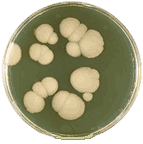Papers in the Biological Sciences
Document Type
Article
Date of this Version
8-2012
Citation
The Japanese Society for Medical Mycology 日本医真菌学会総会プログラム抄録集 53, pp. 38-39 (2012).
Abstract
Most dimorphic fungi exhibit cell density dependent effects in that they grow as yeasts when inoculated at > 106 cells per ml and as mycelia when inoculated at < 106 cells per ml. For Candida albicans, we discovered (2001) that this phenomenon (quorum sensing) is due to the production and secretion of the C15 isoprenoid trans-trans farnesol. Since then, we found that C. albicans cells treated with sublethal levels of zaragozic acid (2003) or fluconazole (2004) produced 10-40X more farnesol and that these fluconazole treated cells were ca. 5X more toxic to mice following tail vein injection. This suggestion that farnesol might act as a virulence factor as well as a QSM was confirmed (2007) when we showed that a mutant of C. albicans which produced only 15% as much farnesol was 5X less toxic to mice; both farnesol production and pathogenicity were restored when the mutant was reconstituted. Farnesol production is regulated in that it is increased 18X in tup1 and nrg1 mutants (2008) but shut down entirely during anaerobic growth (2004) or in the opaque phase of growth (2007). Farnesol is also a bioactive molecule. For example, we showed (2006) that farnesol triggered apoptosis in both Aspergillus nidulans and Aspergillus fumigatus.
Included in
Environmental Microbiology and Microbial Ecology Commons, Other Life Sciences Commons, Pathogenic Microbiology Commons



Comments
Copyright 2012. Used by permission.